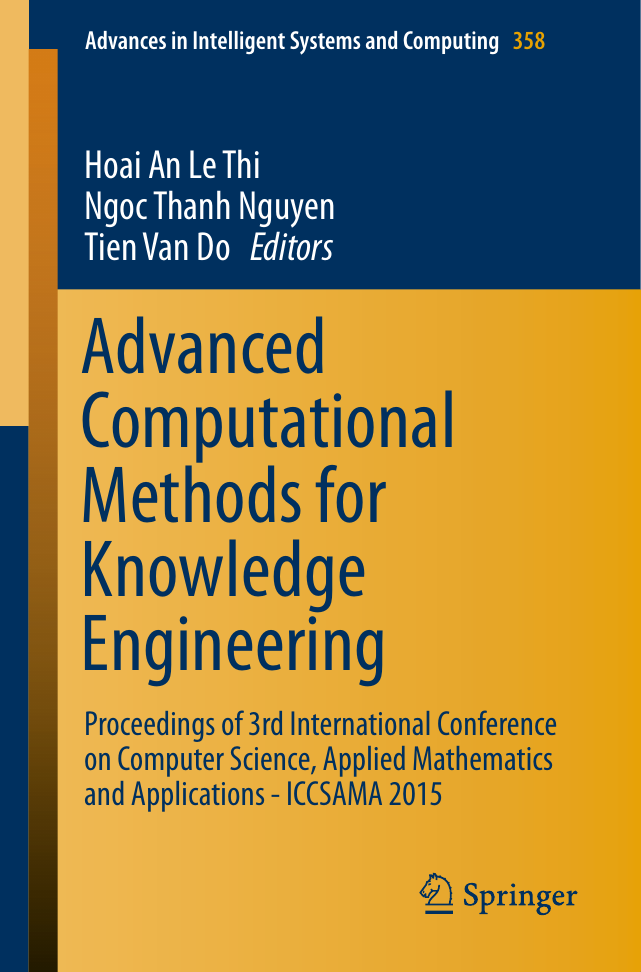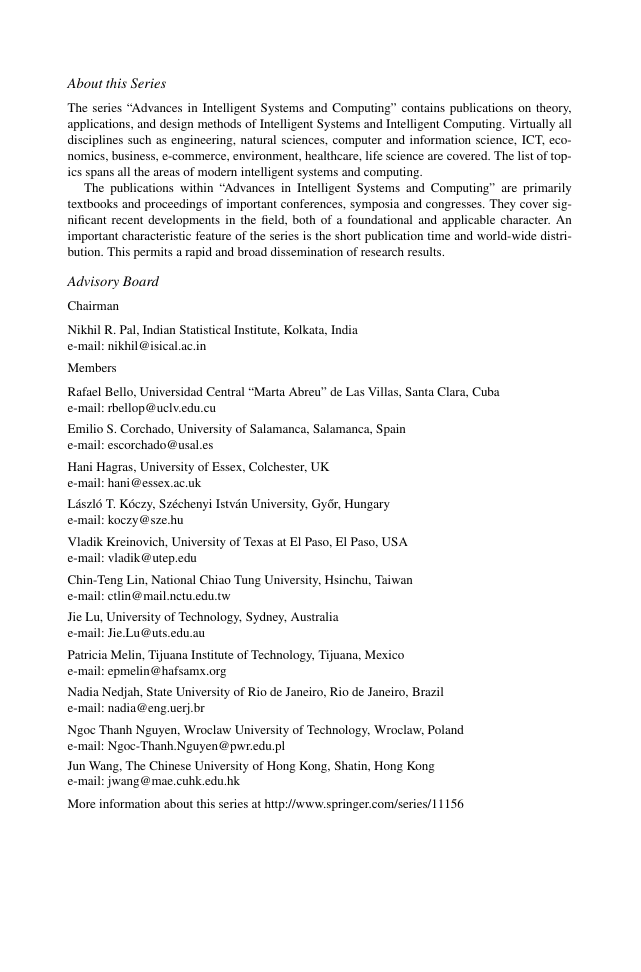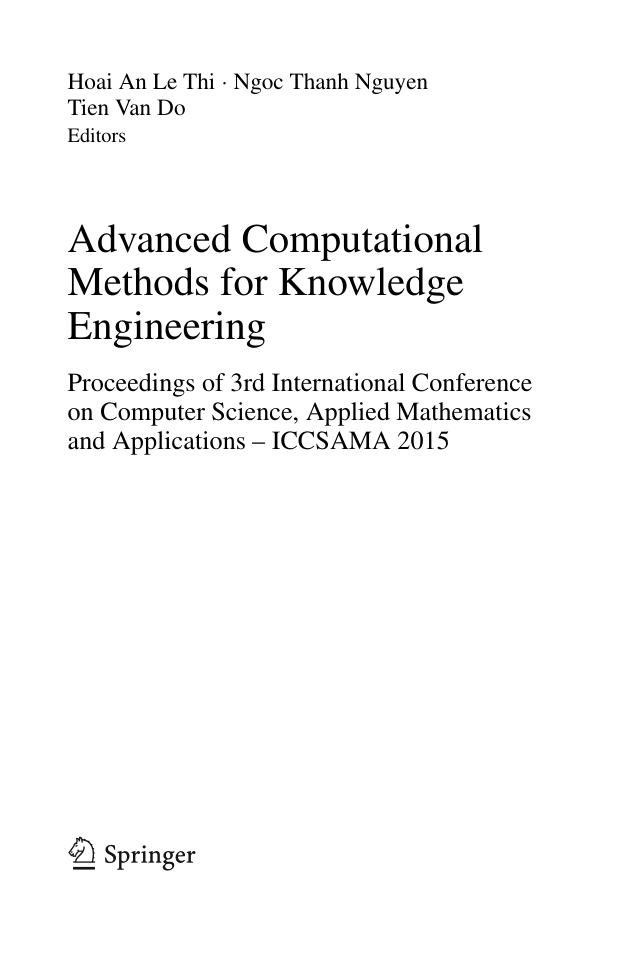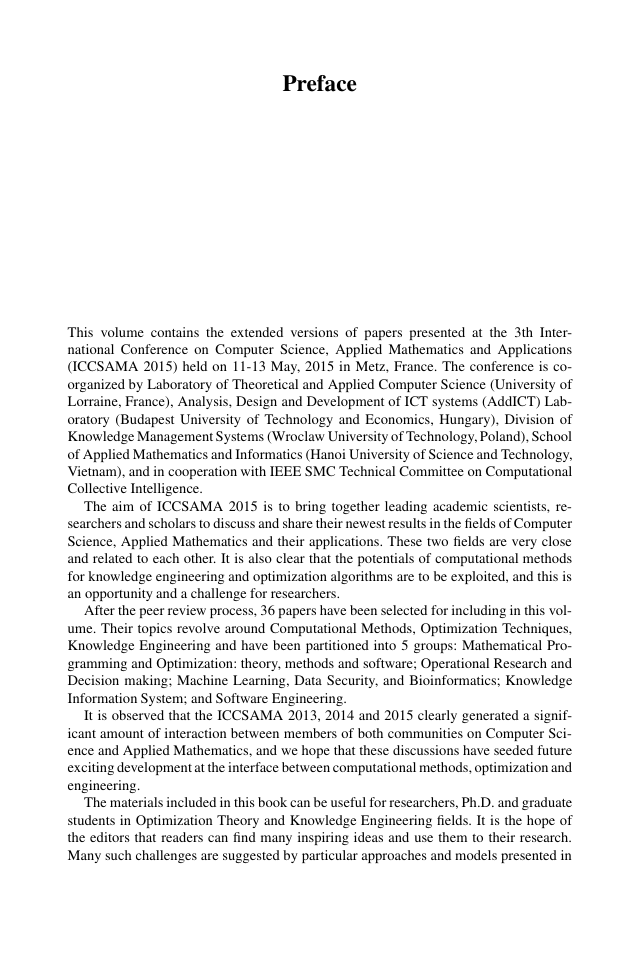Preface
Organization
Contents
Part I: Mathematical Programming and Optimization: Theory, Methods and Software
A Cutting Plane Approach for Solving Linear Bilevel Programming Problems
1 Introduction
2 Solving Linear BLP Problems
3 Numerical Example
4 Conclusion
References
A Direct Method for Determining the Lower Convex Hull of a Finite Point Set in 3D
1 Introduction
2 Preliminaries
3 Lower Convex Hull of a Finite Point Set in 3D
4 Algorithm for Determining the Lower Convex Hull of a Finite Point Set
4.1 Determining Lower Facets
4.2 Main Algorithm and Correctness
5 Numerical Experiments
5.1 Determining the Lower Convex Hull of a Finite Point Set in 3D
5.2 Application for Computing Voronoi Diagrams on a Sphere
References
A Hybrid Intelligent Control System
Based on PMV Optimization for Thermal
Comfort in Smart Buildings
1 Introduction
2 Problem Description
2.1 Building Thermal Model
2.2 Thermal Comfort
3 ProposedMethod
4 Experimentation
5 Conclusion
References
DC Approximation Approach
for �0-minimization in Compressed Sensing
1 Introduction
2 DC Programming and DCA
3 DC Approximation Approach for Solving Problem (1)
4 NumericalExperiments
5 Conclusions
References
DC Programming and DCA Approach
for Resource Allocation Optimization
in OFDMA/TDD Wireless Networks
1 Introduction
2 Problem Statement
3 A Global Optimization Based on DC Programming Approach
3.1 DC Reformulation
3.2 DCA for Solving Problem (7)
4 Computational Experiments
References
DC Programming and DCA for a Novel
Resource Allocation Problem in Emerging Area
of Cooperative Physical Layer Security
1 Introduction and Related Works
2 A Novel Resource Allocation Problem in the Emerging Area of Cooperative Physical Layer Security
3 DC Programming and DCA for Solving the Problem (6)
3.1 A Brief Introduction of DC Programming and DCA
3.2 DC Programming and DCA for the Problem (6)
4 Numerical Results
4.1 Datasets
4.2 Setting Parameters and Stopping Criteria
4.3 Numerical Results and Comments
5 Conclusions
References
Scheduling Problem for Bus Rapid Transit Routes
1 Introduction
2 Optimization Model of BRT Systems
3 A GA-Based Solution Method
4 A Case Study in Hanoi
5 Conclusions
References
Part II:
Operational Researchand Decision Making
Application of Recently Proposed
Metaheuristics to the Sequence Dependent TSP
1 Introduction
2 Background
2.1 Simulated Annealing
2.2 Artificial Bee Colony
2.3 Migrating Birds Optimization
3 Neighbor Functions
4 Experimental Setup, Results and Discussion
4.1 Parameter Fine Tuning
4.2 Determining Best Performing Neighbor Functions
5 Summary, Conclusions and Future Work
References
Comparative Study of Extended Kalman Filter and Particle Filter for Attitude Estimation in Gyroless Low Earth Orbit Spacecraft
1 Introduction
2 Nonlinear Mathematical Model of the Observer
3 Nonlinear Estimation Algorithms
3.1 Extended Kalman Filter
3.2 Particle Filter
4 Result and Discussion
5 Conclusions
References
Graph Coloring Tabu Search
for Project Scheduling
1 Introduction
2 Problem (P1)
2.1 Presentation of the Problem
2.2 Graph Coloring Model Based on the k-GCP
2.3 Tabu Search
2.4 Results
3 Problem (P2)
3.1 Presentation of the Problem
3.2 Graph Coloring Model Based on the Multi-coloring Problem
3.3 Tabu Search
3.4 Results
4 Problem (P3)
4.1 Presentation of the Problem
4.2 Graph Coloring Model Based on the Mixed GCP
4.3 Tabu Search
4.4 Results
5 Conclusion
References
Quality of the Approximation
of Ruin Probabilities Regarding to Large Claims
1 Introduction
2 Strong Stability of a Univariate Classical Risk Model
2.1 Description of the Model
2.2 Strong Stability of a Univariate Classical Risk Model
3 Simulation Based Study
3.1 Algorithm
3.2 Simulated Distributions
3.3 Numerical and Graphical Results
3.4 Discussion of Results
4 Conclusion
References
Part III: Machine Learning, Data Security,
and Bioinformatics
An Improvement of Stability
Based Method to Clustering
1 Introduction
2 The Bootstrap Technique
2.1 An Algorithm Based on Bootstrap for Clustering
2.2 DC Programming and DCA
2.3 Experiments with Bootstrap Techinique and DCA
3 An Improvement of Stability Based Method
4 Testing with Large Number of Dimensions and/or Large Number of Clusters
5 Conclusion
References
A Method for Building a Labeled Named Entity
Recognition Corpus Using Ontologies
1 Introduction
2 Phenotype Named Entity Recognition
2.1 Phenotype Corpora
2.2 Maximum Entropy Model with Beam Search
3 Building Annotated Corpora
3.1 Phenotype Knowledge Resources
3.2 Building Process
3.3 Error Analysis
4 Result and Discussion
5 Conclusion
References
A New Method of Virus Detection Based on Maximum Entropy Model
1 Introduction
2 Model of Virus Detection Systems
3 Developing the Method of Virus Detection Based on MEM
3.1 Extracting Virus Feature
3.2 Applying Maximum Entropy Model for Detecting Virus
3.3 Training Phase
3.4 Phase of Detection Virus
4 Experiment
4.1 Program and Experimental Data
4.2 Experimental Result and Evaluation
5 Conclusion and Future Work
References
A Parallel Algorithm for Frequent Subgraph Mining
1 Introduction
2 Related Work
3 Multi-core Processor Architecture
4 gSpan Algorithm
5 Proposed Algorithms
5.1 Parallel Mining Frequent Subgraphs with Independent Branch Strategy
5.2 Example
6 Experiments
7 Conclusions and Future Work
References
Combining Random Sub Space Algorithm and Support Vector Machines Classifier for Arabic Opinions Analysis
1 Introduction
2 Related Works
3 Random Sub Space
4 System Architecture
4.1 The Arabic Corpus Construction and Manual Pre-treatment
4.2 Features Extraction
4.3 RSS-SVM Hybrid Classifier
5 Analysis of Resu ults
6 Conclusion
References
Efficient Privacy Preserving Data Audit in Cloud
1 Introduction
2 The Three-Parties Auditing Model
2.1 System Model
3 Proposed Method
3.1 Description
3.2 Correctness
4 Analysis
4.1 Storage Overhead, Communication Cost and Computation Complexity
4.2 Security
4.3 Comparison to the State-of-Art Schemes
5 Conclusion
References
Incremental Mining Class Association Rules Using Diffsets
1 Introduction
2 Related Work
2.1 Basic Concepts
2.2 Mining Class Association Rules
2.3 Mining Association Rules from Incremental Datasets
2.4 Mining Class Association Rules from Incremental Datasets
3 A Method for Updating CARs in Incremental Dataset Using Diffsets
3.1 CAR-Incre-Diff Algorithm
3.2 An Illustrative Example
4 Experiments
5 Conclusions and Future Work
References
Mathematical Morphology on Soft Sets
for Application to Metabolic Networks
1 Introduction
2 Lattice Structures on Soft Sets
3 Morphological Operators on Soft Sets
4 Mathematical Morphology on Metabolical Networks
5 Morphological Dilation Dualities
6 Conclusions
References
Molecular Screening of Azurin-Like Anticancer Bacteriocins from Human Gut Microflora Using Bioinformatics
1 Introduction
2 Methods
2.1 Selection of the Human Gut Microbiome
2.2 Identification of Probable Bacteriocins from Human Gut Microbiome
2.3 Screening of Potentially Anticancer Bacteriocins
3 Results
3.1 Identification of Probable Bacteriocins from Human Gut Microbiome
3.2 Screening of Potentially Anticancer Bacteriocins
4 Discussions
References
Non-linear Classification of Massive Datasets with a Parallel Algorithm of Local Support Vector Machines
1 Introduction
2 Support Vector Machines
3 Parallel Algorithm of Local Support Vector Machines
4 Evaluation
5 Discussion on RelatedWorks
6 Conclusion and Future Works
References
On the Efficiency of Query-Subquery Nets withRight/Tail-Recursion Elimination in Evaluating Queries to Horn Knowledge Bases
1 Introduction
2 Preliminaries
3 QSQ-Nets with Right/Tail-Recursion Elimination
4 Preliminary Experiments
5 Conclusions
References
Parallel Multiclass Logistic Regression for Classifying Large Scale Image Datasets
1 Introduction
2 Logistic Regression for Two-Class Problems
3 Extentions of Logistic Regression to Large Number of Classes
3.1 Balanced Batch of Logistic Regression
3.2 Parallel LR-BBatch-SGD Training
4 Evaluation
4.1 Datasets
4.2 Classificaton Results
5 Conclusion and Future Works
References
Statistical Features for Emboli Identification Using Clustering Technique
1 Introduction
1.1 Limitation of Classification Technique
2 Methodology
2.1 k-Means Algorithm
2.2 Features Extraction
3 Result and Discussion
3.1 Experimental Setup
3.2 Statistical Analysis
3.3 Results
3.4 Discussion
4 Conclusion
References
Twitter Sentiment Analysis
Using Machine Learning Techniques
1 Introduction
2 Related Works
3 Our Approach
3.1 Pre-processing of Data
3.2 Feature Extraction
3.3 Classification Model
4 Experiments and Evalutions
4.1 Experiments
4.2 Evalutions
5 Conclusions
References
Video Recommendation Using Neuro-Fuzzy on Social TV Environment
1 Introduction
2 User Behaviors-Based CF Using Neuro-Fuzzy Network
2.1 ProfileModeling
2.2 Content-Based Filtering Using Neuro-Fuzzy Network
3 Experiments
3.1 Data Set
3.2 EvaluationMethods
3.3 Evaluation Results
4 Conclusion
References
Part IV:
Knowledge Information System
A Two-Stage Consensus-Based Approach for Determining Collective Knowledge
1 Introduction
2 Preliminaries
2.1 Collective of Knowledge States
2.2 Consensus Choice
2.3 Knowledge of Collective
2.4 Quality of Collective Knowledge
3 The Proposed Method
4 Experiments and Evaluation
4.1 Experimental Results
4.2 Experimental Evaluation
5 Conclusions
References
Context in Ontology for Knowledge Representation
1 Introduction
2 Related Works
3 Ontology Metamodel
4 Context
4.1 Usage and Utility
4.2 Integration to the Ontology Model
5 Conclusion
References
Designing a Tableau Reasoner
for Description Logics
1 Introduction
2 Tableaux with Global Caching
3 Design Principles
3.1 Avoiding Costly Recomputations by Caching
3.2 Memory Management
3.3 Search Strategies
4 Some Other Optimization Techniques
4.1 Delaying Time-Consuming Subtasks
4.2 Converting TBoxes
4.3 Ontology Classification
5 Conclusions
References
Granular Floor Plan Representation
for Evacuation Modeling
1 Introduction
2 The Evacuation Process
3 Our Goal: Desired Fire Scene Representation
4 Geometric Network Construction
5 Conclusions and Future Work
References
Integrated Assessment Model on Global-Scale Emissions of Air Pollutants
1 Introduction
2 Related Work
3 GAINS-IAM Concepts
3.1 GAINS-IAM Global Emission Concepts
3.2 GAINS IAM Data Model
3.3 Specifying GAINS IAM Data Cubes
4 Implementing Results of the GAINS-IAM Data Model
4.1 Global Activity Pathway Data
4.2 Global Emission Data Cube
5 Conclusion
References
Query-Subquery Nets with Stratified Negation
1 Introduction
2 Preliminaries
3 Query-Subquery Nets with Stratified Negation
4 Preliminary Experiments
5 Conclusions
References
Part V:
Software Engineering
Distributed Hierarchy of Clusters
in the Presence of Topological Changes
1 Introduction
1.1 Related Works
1.2 Model and Problem Statement
2 Algorithm
2.1 Clustering
2.2 Virtual Nodes
2.3 Hierarchical Clustering
3 Example
4 Conclusion and Perspectives
References
Native Runtime Environment
for Internet of Things
1 Introduction
2 Related Work
3 Design
3.1 VMXL4 Microkernel
3.2 VMXPOSIX Native Runtime Environment
4 Implementation
4.1 Functions for File Operations
4.2 fork() System Call
4.3 Standard Input Implementation
5 Experimental Evaluation
5.1 File Operations Test Scenario
5.2 fork() System Call Test Scenario
5.3 Standard Input Test Scenario
6 Conclusion and Further Work
References
Searching for Strongly Subsuming Higher Order Mutants by Applying Multi-objective Optimization Algorithm
1 Introduction
2 HOMs Classification
3 Identify HOMs Based on Objective and Fitness Functions
4 Experimental Evaluation
4.1 Research Questions
4.2 Software under Test and Supporting Tool
4.3 Multi-objective Optimization Algorithm
4.4 Results and Analysis
5 Conclusion and Future Work
References
Some Practical Aspects
on Modelling Server Clusters
1 Introduction
2 System Modelling
3 Performance Measures
4 Simulation Experiments
5 Conclusion
References
Author Index
















 2023年江西萍乡中考道德与法治真题及答案.doc
2023年江西萍乡中考道德与法治真题及答案.doc 2012年重庆南川中考生物真题及答案.doc
2012年重庆南川中考生物真题及答案.doc 2013年江西师范大学地理学综合及文艺理论基础考研真题.doc
2013年江西师范大学地理学综合及文艺理论基础考研真题.doc 2020年四川甘孜小升初语文真题及答案I卷.doc
2020年四川甘孜小升初语文真题及答案I卷.doc 2020年注册岩土工程师专业基础考试真题及答案.doc
2020年注册岩土工程师专业基础考试真题及答案.doc 2023-2024学年福建省厦门市九年级上学期数学月考试题及答案.doc
2023-2024学年福建省厦门市九年级上学期数学月考试题及答案.doc 2021-2022学年辽宁省沈阳市大东区九年级上学期语文期末试题及答案.doc
2021-2022学年辽宁省沈阳市大东区九年级上学期语文期末试题及答案.doc 2022-2023学年北京东城区初三第一学期物理期末试卷及答案.doc
2022-2023学年北京东城区初三第一学期物理期末试卷及答案.doc 2018上半年江西教师资格初中地理学科知识与教学能力真题及答案.doc
2018上半年江西教师资格初中地理学科知识与教学能力真题及答案.doc 2012年河北国家公务员申论考试真题及答案-省级.doc
2012年河北国家公务员申论考试真题及答案-省级.doc 2020-2021学年江苏省扬州市江都区邵樊片九年级上学期数学第一次质量检测试题及答案.doc
2020-2021学年江苏省扬州市江都区邵樊片九年级上学期数学第一次质量检测试题及答案.doc 2022下半年黑龙江教师资格证中学综合素质真题及答案.doc
2022下半年黑龙江教师资格证中学综合素质真题及答案.doc